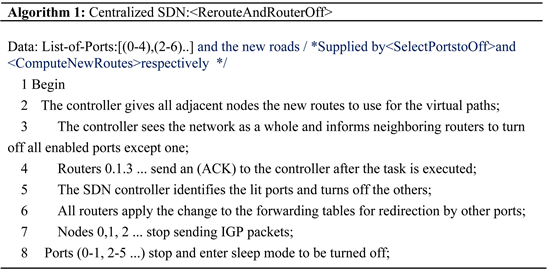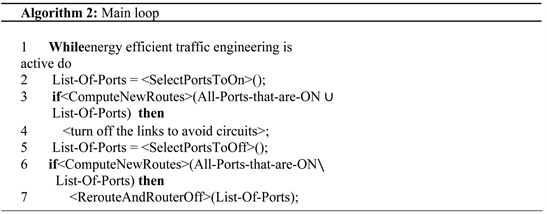Contribution to the Optimization of the Energy Consumption in SDN Networks ()
1. Introduction
Communication networks are progressively evolving in terms of size and performance. There are two types of network equipment: active devices such as routers, switches, etc. (information transmission devices) and passive devices such as cables, fiber optics, etc. (interconnection equipment). Of the two types of equipment, only assets are energy intensive. The evolution of the networks leads to an increase of these equipments in quantity and in performance. The increase of these and their performance increases the consumption of the electrical energy they need for their operation.
A study conducted in 2009 [1] shows that information and telecommunications technologies (ICTs) alone consume 2% to 10% of global energy consumption. Hubs, switches and routers consume 6 Twh/year in the USA [2] . Therefore the search for a mathematical model for the consumption of energy in the communication networks becomes a real concern for the companies of the moment. In traditional networks, when a packet arrives on a port of a switch or router, it applies the routing or switching rules that are registered in an operating system. Generally, all packets that have the same destination follow the same path. In high-end models, hardware is able to recognize the type of application and apply the specific rules to it. But this programming is rigid. It can only be changed manually by the administrator, which obviously takes time [3] .
The advent of Software Defined Network (SDN) technologies appears to be a good alternative for acting remotely and dynamically on equipment in order to model energy consumption.
In SDN technology, it is a centralized controller that will be responsible for routing packets in the network via SDN protocol (openflow) by programmability by injecting routing rules provided by the application layer (Figure 1).
In this paper, we use this paradigm to act on network devices by enabling or disabling router ports when they are not working. A new strategy has been developed which takes into account the peak periods (dense traffic) and normal (low traffic) minimizing energy while avoiding congestion. The authors of [4] have in their minimized approach with high delays leading to packet losses.
Our model is based on that of these authors [4] . We have implemented an energy minimization model based on a new strategy. Our work will revolve around the following points:
Section 2 will cover previous work. Section 3 describes the mathematical model of our approach. We present in Section 4, the resolution approach. In Section 5, we will evaluate the performance of the model. Section 6 concludes our article.
2. Previous Work
In this section, we will present some previous work that has addressed the issue of energy consumption in networks. We also formulate some basic assumptions that our future mathematical model must respect.
2.1. Mathematical Model Research Reduce Energy Consumption Optimally
The consumption of energy has been treated by some researchers [4] [5] [6] [7] [8] . In [4] , the authors have minimized under three constraints using on/off technology in conventional wired networks, the consumption of energy in the networks (delay, packet loss and jitter). A saving of 40% was obtained. But at each extinction, a delay variation led to packet losses in case of heavy traffic. The authors of [5] [8] minimized the energy in SDN networks using the “compression” approach of the routing table. According to the authors, the devices that can implement the SDN rules uses TCAM (Content-addressable Ternary Memory). This memory in which are recorded the rules, is expensive and greedy in energy. So you have to compress the routing table. Compression maximizes rule space, increasing the number of paths. The consumption of a high-capacity link and that of an unsolicited link is low, some flows can be redirected to other links. As a delay solution, the authors have defined the default rule for forwarding packets to the default port without contacting the SDN controller. An energy saving has been observed but with degradation of the quality of service in terms of congestion in the network. As for the works of [6] and [7] , the authors have shown that it is the number of ports of the routers on the network that consume. Consumption modeling would reduce router interfaces when they are not in use.
We orient our work in this way while finding a mathematical model of energy minimization in the SDN network which satisfies the “QoS” in terms of delay of transmission and loss of packets.
2.2. Basic Assumptions
• Each port has the same rate of energy consumption.
• Each port can handle multiple services so it can redirect traffic.
• Choose in the graph, the path or paths that seem to offer more energy saving.
Our future mathematical model will be obtained through a set of processes that will involve theories such as graphs; trees etc.
3. Modeling the Problem
This section will cover the description of our mathematical model.
We formulate our problem as a linear integer program in contributing to the optimization of energy consumption in SDN networks. Let N be a network and n(t) a sub-network of N (
). We defined a dynamic approach based on two situations of graph theory:
1) The activation and deactivation of the ports of the routers for a given time t. we note the change in energy consumption.
2) We will assume that a router cannot be turned off and therefore must remain awake.
Once switched on, at each given instant t, a link is established between a router i and a router j. It will therefore be a question of maximizing a number of ports to be deactivated in order to have energy savings under “QoS” constraints. In our approach, we will enable or disable router ports using a smart approach.
The number of ports to disable
is defined as:
Consider
, the total number of ports on a router. This parameter
is fixed and depends on the types of routers. If the total number of ports on a router is 8, how much should I disable and how, to hope to save the maximum energy?
Let us consider the function f: the consumption of energy in the sub-networks. We express the model of our approach in mathematical from called objective function of the solution of the problem that is to say (1) and (2).
Which amounts to:
(1)
A link is the junction between two routers interfaces.
having a maximum load capacity of
packet traffic per second. The links can be in the following state 0 or 1. Let k be the link state variable: 0 state where the router is off and 1 state where the router is on.
The objective function to be minimized becomes:
(2)
where
is the energy consumption of the router i whose
ports were deactivated at time t and
represents the energy of the link i, j at time t.
is the function to be explained. Power gain function of router i: “g”. The function g is a linear and increasing function with respect to the number of ports deactivated at time t.
Let
: the energy gain of the router i such that:
, with
where
.
if
, then
(3)
This is the final expression of our function “energy consumption” of router. Otherwise
where Ci is the total consumption of the router i and
.
We deduce that if all ports are disabled,
.
We showed above that our function is linear in
. It is thus refined in the form of:
Now every affine function is convex and therefore admits a minimum. Our model then becomes:
(4)
With Ci = chassis consumption (Cch) + consumption of ports (Cp) on. From where:
The explicit objective function becomes:
(5)
Under constraint of:
Summary of the ratings:
We have found our mathematical model which minimizes, so a method of resolution proves necessary.
4. Resolution Approach
In this part, we proposed a resolution method of our mathematical model.
Solving the problem consists of:
• Solve by integer linear programming
• Solve by the Kruskal algorithm by looking for the maximal tree the function
4.1. Principle of Resolution
We are going to build a network (lowest total weight covering tree) from which we will obtain our possible energy savings. The ports to be shut down will consist of those of the adjacent routers. For our simulation, we will use a network of 7 routers each with 8 ports and 9 links. All extinctions of adjacent ports cause those of these links (Figure 2).
Our tree covering the lowest total weight becomes (see Figure 3).
Total weight: 12 + 12 + 12 + 4 + 4 + 5 = 49.
4.2. Port Extinction/Ignition Algorithm
Our demand-side extinguishing strategy must select all ports that are not affected by the request and dynamically shut them down.
![]()
Figure 2. Network with link capabilities.
![]()
Figure 3. Architecture obtained by the Kruskal algorithm.
In our approach, when a router is turned on, it establishes a link with its neighbors and so on in the network.
Our 7-router network has 8 ports each, only one port is turned on and the (n − 1) ports are off with its links. The circuits are to be avoided in the choice of favorable paths (having the lowest weight).
The Modified SPRING Protocol (MSP), is responsible for the extinction of ports and links unsolicited by the request (see Algorithms below).


This Figure 3 (maximum tree of minimum weight) is obtained thanks to the Kruskal algorithm. The ports of the adjacent routers are stopped using a modification of the SPRING or Segment Routing algorithm as well as the links (see algorithms) [9] . Note that SPRING is designed for SDN.
The resolution approach having been found, we will evaluate the performance of our model.
5. Evaluation and Performance
In Table 1 below, we present our results.
![]()
Table 1. Evaluation of our approach.
In our model, we explained high (see 4.1) that the extinct ports are those of adjacent routers. Once the port is off, it drives the one of its links. The SDN is a technology based on the programmability of remote equipment via a centralized controller in the network. The SDN controller, thanks to its global view of the network, is responsible for the extinction of the ports and links, if they are not used by means of a modification of the algorithm SPRING.
Our Table 1 is obtained from Figure 2 and Figure 3. We applied the Kruskal algorithm to obtain the tree with the lowest weight. This allowed us to have 3 disabled links out of 9. However, we used a network of 7 routers each having 8 ports from which 7 × 8 = 56 total ports in the network. When the routers are turned on, only one port on each router is enabled and the n − 1 ports are off. In our case, there are 7 ports off on each router i, so 49 (7 × 7) in total in the network (see Table 1).
6. Conclusions
Our mathematical model in SDN networks minimizes energy consumption. Any router chosen, disabling some ports would give a strong energy saving by this model. Our model is flexible and gives us a double energy saving in ports and links. In the ports, an extinction of 87.5% is possible to make savings and 33.33% in the links to also make savings.
In this article, we found our mathematical model; however, improvements are possible and will be the subject of our future work.